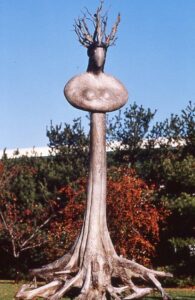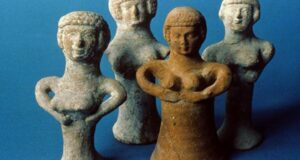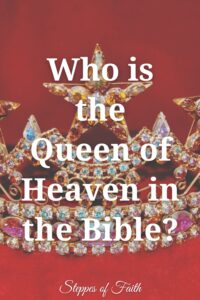
“And the women knead dough to make cakes for the queen of heaven.” Jeremiah 7:18
The Bible makes two references to a “queen of heaven,” both times in the book of Jeremiah.
In chapter seven, the Israelites have flagrantly adopted pagan idol worship practices thanks to King Ahaz (also called Ahab) of Judah (2 Kings 16; 735-715 B.C.). Under his Phoenician wife Jezebel’s influence, he burned incense to the Phoenician pagan god Molech (aka Baal), erected worship poles in the high places, and set up a child sacrifice system, with his son among the first sacrificed. As a result, God, in His anger, sent the Israelites into Assyrian captivity (2 Kings 17).
Following the Israelites’ return from captivity, Ahaz and Jezebel’s daughter, Athaliah, married the Judean King Jehoram, and she influenced her husband to continue promoting pagan worship of Molech/Baal (2 Kings 8:16-18). Their son, Ahaziah, also maintained the practice.
Athaliah’s brother, King Hezekiah, attempted to point the Israelites back to the one true God when he came to power (2 Chronicles 29-31). One of the first things he did was purge the land from all idols and restore the people to the Lord.
“He removed the high places and broke the sacred pillars, cut down the wooden image, and broke in pieces the bronze serpent that Moses had made (Numbers 21:9), for until those days, the children of Israel burned incense to it and called it Nehushtan.” (2 Kings 18:4, my addition)
Unfortunately, upon his ascension to the throne, Hezekiah’s son, Manasseh, restored his grandfather Ahaz’s practices (2 Kings 21). He also re-established worship poles to the “queen of heaven.”
Entire families worshipped Molech (Baal) and his wife, the proclaimed queen of heaven who was also known by many other names—Ishtar (Sumerian), Isis (Egyptian), Astarte/Aphrodite (Greek), and, to the Israelites, Asherah.
Children would gather wood, men used the wood to build the altars upon which the children were sacrificed, and women baked bread and made drink offerings to the queen of heaven. The women especially worshiped her as a fertility goddess since bearing children was so culturally vital at the time.
These pagan practices compelled the prophet Jeremiah to preach and prophesy against the Israelites, warning them of God’s impending judgment if they did not repent. But the pagan religious practices were already too ingrained and intertwined in Jewish culture.

The Israelites’ Pagan Worship of the Queen
Naturally, the people’s pagan worship enraged the Lord, as we see in both Jeremiah 7 and 44.
“Therefore, do not pray for this people, nor lift up a cry or prayer for them, nor make intercession to Me, for I will not hear you. ‘Do they provoke Me to anger?’ says the LORD. ‘Do they not provoke themselves to the shame of their own faces?’ Therefore, thus says the LORD GOD: ‘Behold, My anger and My fury will be poured out on this place—on man and on beast, on the trees of the field and on the fruit of the ground. And it will burn and not be quenched.” (Jeremiah 7:16,19-20)
“Therefore, thus says the LORD of the God of Israel: ‘Behold, I will set My face against you for catastrophe and for cutting off all Judah.’” (Jeremiah 44:11)
Jeremiah did his best to move the people to repent of their rampant idol worship. But, like anyone who worships something or someone more than they do God, they would not listen. Instead, out of their close-minded selfishness, they defended the women who worshiped the queen of heaven.
“Then all the men who knew that their wives had burned incense to other gods, with all the women who stood by…answered Jeremiah, saying, ‘As for the word that you have spoken to us in the name of the LORD, we will not listen to you! But we will certainly do whatever has gone out of our own mouth, to burn incense to the queen of heaven and pour out drink offerings to her, as we have done, we and our fathers, our kings, and our princes, in the cities of Juda and in the streets of Jerusalem.’” (44:15-17)
The men wholeheartedly believed that their good fortune came from the queen of heaven and not from God. They even went so far as to say they lost their prosperity if they briefly quit making sacrifices to her. In their own pitiful defense, the women declared they were innocent of God’s wrath because their husbands had permitted them to worship the queen (v19).
Such paganism is an abomination to the Lord. So, just as He had done with King Ahaz, He again cast judgment on the Israelites and sent them back into captivity, this time under the Babylonian King Nebuchadnezzar (2 Kings 21:12-14), who expanded their idol worship practices.
Clearly, the Israelites’ beliefs and commitment to the queen of heaven were quite strong. They were willing to kill for her, die for her, and sacrifice everything they owned for her. Which makes one ask, who is she?
Mixing the Queen with the King of Heaven
Pagan culture asserted that the queen of heaven (commonly called Asherah in the Bible) was both Molech/Baal’s wife and his mother (1 Kings 18). Legend says they birthed 70 other gods together. Many also believed she was the wife of a Canaanite pagan god called El. Unfortunately, over time, the people became confused about who her husband really was.
Some said her husband was El. Yet, the Hebrew word for God is Elohim, causing many people to eventually believe that the queen of heaven was married to the holy God of Israel. This corrupt blending of a holy God with a pagan goddess became part of everyday religious practice. Of course, the idea that she is a paramour of the true King of Heaven is entirely idolatrous, crude, and unbiblical.
Worship of the queen of heaven was not limited to the Israelites. According to Will Durant in his book The Life of Greece, the Babylonians also revered her as Ishtar, “The Virgin,” “The Holy Virgin,” “the Virgin Mother,” “Goddess of Goddesses,” and “Queen of Heaven and Earth.” She was the “shining light of heaven, light of the world, enlightener of all the places where men dwell, who gatherist together the hosts of the nations.”
The Babylonians would also cry out, “Ishtar is great! Ishtar is Queen! My Lady is exalted, my Lady is Queen. There is none like unto her.”
Much like the Israelites, the Babylonians also believed the queen of heaven’s lover was also her son, the exception being they called him Tammuz instead of Molech or Baal.
Thankfully, people eventually gave up the practice of child sacrifice, but erecting poles made of wood or stone in honor of Asherah, the presumed queen of heaven, continued.
[RELATED READING: Separating Fact from Myth: Asherah and Idol Worship]
Some scholars believe the poles eventually became a mere cult symbol, with no one knowing who Asherah was. Others believe they persisted in representing the goddess, similar to the cross being a representation of Jesus. Still others believe the poles (representing a goddess of fertility) were replaced with magical rabbits who laid eggs filled with good fortune for women to find.

The Queen and the Catholic Church
The belief that a “queen of heaven” was also a mother gave rise to the theme of “Mother and Child.”
Dating back to the Babylonian Empire, the idea of a “Mother and Child” is found in countless nations, such as Spain, Portugal, Africa, France, Germany, Bulgaria, and as far as Mexico and China. Since then, the “Mother and Child” motif has persisted, even in modern times. In each case, the idea is that the queen of heaven gave birth to a son while still a virgin.
More recently, priests and popes within the Roman Catholic Church promoted the modern view that the queen of heaven is Mary, the mother of Jesus. They pointed to Luke 1, when the archangel Gabriel visited Mary to announce the birth of the Messiah, as the basis for their belief.
A few theologists (very few) assert that the Catholic Church invited pagan worshipers into their churches in ancient times in an act of syncretism, where pagan beliefs and church practices are blended. According to the theologists, the church allowed the pagans to worship their mother-goddess, the queen of heaven, within the church to increase the number of members.
The story goes that, over time, the church eventually identified the queen of heaven as Mary and put a Christian face on the pagan worship of Asherah. The thought is syncretism continues to this day. There is no sound basis for this belief. However, it cannot be emphasized enough that worshiping Mary as the queen of heaven is soundly unbiblical.
Mary is Not the Queen
Officially, today’s Catholic Church only encourages the honoring of Mary. However, many people come dangerously close to worshiping her. Jesus, our Lord and Savior, does not support this. In Luke 11, Jesus rebuked a woman who cried out that Mary, His mother, was surely worthy of worship.
“And it happened, as He spoke these things, that a certain woman from the crowd raised her voice and said to Him, ‘Blessed is the womb that bore you, and the breasts which nursed You!’ But He said, ‘More than that, blessed are those who hear the word of God and keep it!’” (Luke 11:27-28)
His pointed response illustrates that Mary, though blessed, should never be considered an object of worship–not her or any other person–and that those who keep His commands are more blessed. Most significantly, Mary herself refused any idea of personal worship in her “Magnificant” in Luke 1:46-55.
“And my spirit has rejoiced in God my Savior, for He has regarded the lowly state of His maidservant. For behold, henceforth, all generations will call me blessed, for He who is mighty has done great things for me, and holy is His name.” (v47-49)
In her own words, Mary humbly acknowledges that she is neither divine nor immaculate but someone in need of a Savior and His grace just like us.

Worship the One True God
For unknown reasons, people through the centuries want to believe that God has a wife or that He is somehow connected to a divine female being who should be prayed to and worshiped. But these beliefs are wholly unbiblical and idolatrous.
The queen of heaven does not exist. There has never been a queen, and there never will be one. The King of Kings does not have a queen in any way, shape, or form. He alone sits on the throne of heaven, and He shares it with no one. Mentions of a heavenly queen in the book of Jeremiah are simply references to an ancient mythical pagan goddess.
In all cases, we would do well to remember the first two commandments God gave us:
“You shall have no other gods before Me. You shall not make for yourself a carved image—any likeness of anything that is in heaven above, or that is in the earth beneath, or that is in the water under the earth. You shall not bow down to them nor serve them. For I, the LORD your God, am a jealous God.” (Exodus 20:3-5)

Catholics do not like to listen…
This is often true, unfortunately.
Thank you Gina. Very insightful.
I may have a theory as to why cultures throughout history wanted to believe that God had a wife.
Perhaps the reason lies in the fact that men throughout history have always known how much better their lives were or could have been while married to a Godly woman ( I personally know mine is!!) So, naturally God would want to be married as well. Right?
Just a theory.
That could be one theory, but that would be humanizing God. He is by no means human. But it is wonderful that you have a godly wife. The Bible says you are very blessed for it, as I know you are.